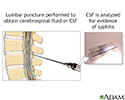CSF-VDRL test
Venereal disease research laboratory slide test - CSF; Neurosyphilis - VDRLThe CSF-VDRL test is used to help diagnose neurosyphilis. It looks for substances (proteins) called antibodies, which are sometimes produced by the body in reaction to the syphilis-causing bacteria.
Neurosyphilis
Neurosyphilis is a bacterial infection of the brain or spinal cord. It usually occurs in people who have had untreated syphilis for many years....

Antibodies
An antibody is a protein produced by the body's immune system when it detects harmful substances, called antigens. Examples of antigens include micr...

How the Test is Performed
A sample of spinal fluid is needed.
Sample of spinal fluid
Cerebrospinal fluid (CSF) collection is a test to look at the fluid that surrounds the brain and spinal cord. CSF acts as a cushion, protecting the b...

How to Prepare for the Test
Follow your health care provider's instructions on how to prepare for this test.
Why the Test is Performed
The CSF-VDRL test is done to diagnose syphilis in the brain or spinal cord. Brain and spinal cord involvement is often a sign of late-stage syphilis.
Blood screening tests (VDRL and RPR) are better at detecting middle-stage (secondary or latent) syphilis.
VDRL
The VDRL test is a screening test for syphilis. It measures substances (proteins), called antibodies, which your body may produce if you have been i...

RPR
RPR (rapid plasma reagin) is a screening test for syphilis. It measures substances (proteins) called antibodies that are present in the blood of peo...

Normal Results
A negative result is normal.
False-negatives can occur. This means you can have syphilis even if this test is normal. Therefore, a negative test does not always rule out the infection. Other signs and tests may be used to diagnose neurosyphilis.
What Abnormal Results Mean
A positive result is abnormal and is a sign of neurosyphilis.
Risks
Risks for this test are those related to lumbar puncture, which may include:
- Bleeding into the spinal canal or around the brain (subdural hematomas).
- Discomfort during the test.
- Headache after the test that can last a few hours or days. If headaches last more than a few days (especially when you sit, stand or walk) you might have a CSF-leak. You should talk to your physician if this occurs.
- Hypersensitivity (allergic) reaction to the anesthetic.
- Infection introduced by the needle going through the skin.
Your provider can tell you about any other risks.
References
Karcher DS, McPherson RA. Cerebrospinal, synovial, serous body fluids, and alternative specimens. In: McPherson RA, Pincus MR, eds. Henry's Clinical Diagnosis and Management by Laboratory Methods. 24th ed. Philadelphia, PA: Elsevier; 2022:chap 30.
Radolf JD, Tramont EC, Salazar JC. Syphilis (Treponema pallidum). In: Bennett JE, Dolin R, Blaser MJ, eds. Mandell, Douglas, and Bennett's Principles and Practice of Infectious Diseases. 9th ed. Philadelphia, PA: Elsevier; 2020:chap 237.
-
CSF test for syphilis - illustration
Venereal disease research laboratory test (VDRL) of the cerebrospinal fluid (CSF) is used to screen for syphilis. CSF is a clear fluid that circulates in the space surrounding the spinal cord.
CSF test for syphilis
illustration
Review Date: 8/26/2023
Reviewed By: Jatin M. Vyas, MD, PhD, Roy and Diana Vagelos Professor in Medicine, Columbia University Vagelos College of Physicians and Surgeons, Division of Infectious Diseases, Department of Medicine, New York, NY. Also reviewed by David C. Dugdale, MD, Medical Director, Brenda Conaway, Editorial Director, and the A.D.A.M. Editorial team.


